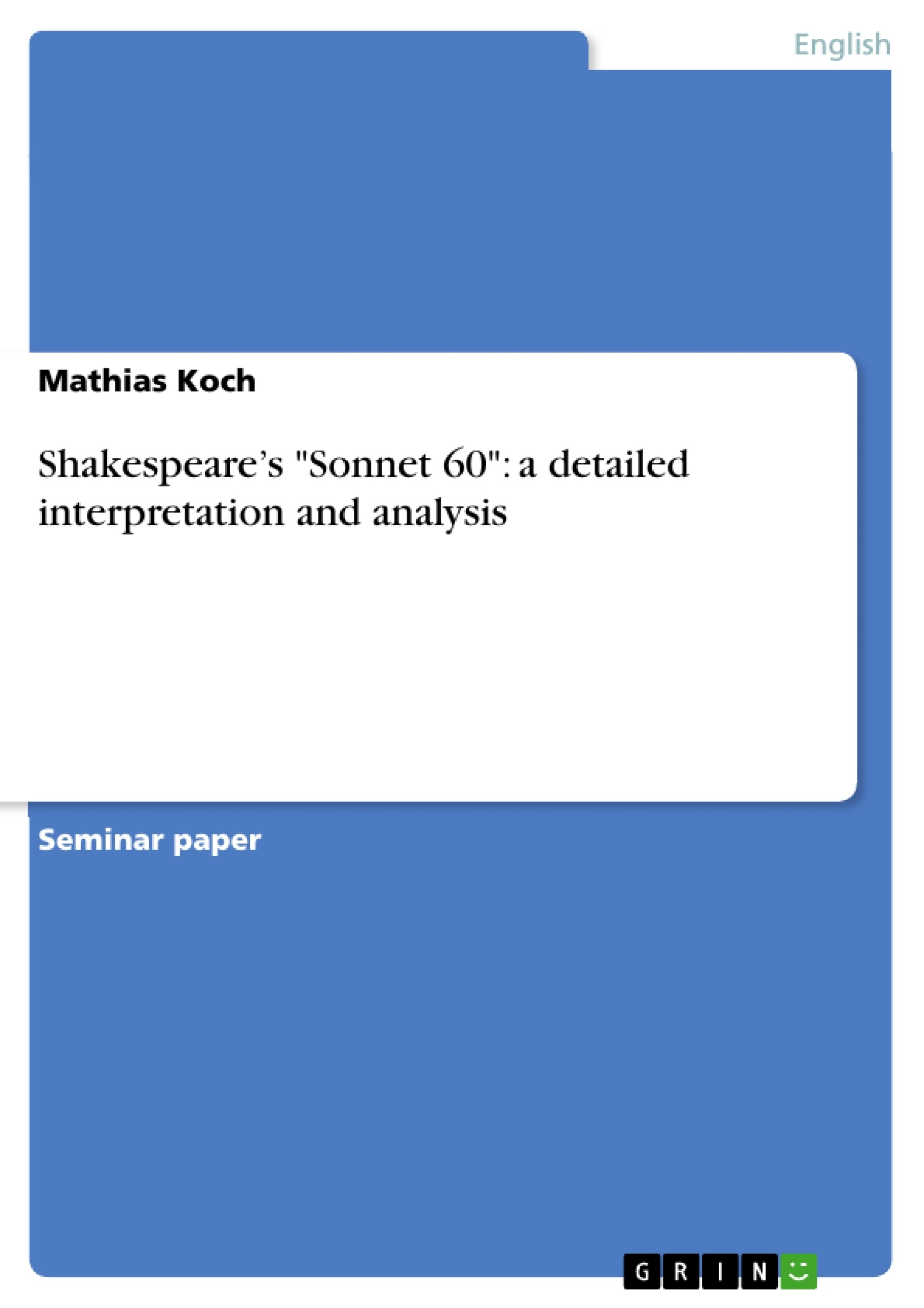This text will give a brief survey on the history of the Sonnet. Following this, it will concentrate on Shakespeare and his work. Firstly, it will present a short overview of the contents of all his sonnets and secondly there will be a detailed interpretation and analysis of Sonnet 60.
Table of Contents
- 1. Introduction
- 2. The History of the Sonnet
- 3. Shakespearean Sonnets
- 4. Analysis and Interpretation of Sonnet 60
Objectives and Key Themes
This text aims to provide a concise overview of the sonnet's history, focusing on Shakespeare's contributions. It will explore the thematic content of Shakespeare's sonnets as a whole before providing a detailed analysis of Sonnet 60.
- The history and evolution of the sonnet form.
- Shakespeare's sonnet cycle and its thematic concerns.
- The concept of time and mortality in Shakespearean sonnets.
- Detailed interpretation of Shakespeare's Sonnet 60.
- The use of imagery and symbolism in Shakespeare's poetry.
Chapter Summaries
1. Introduction: This introductory chapter sets the stage for the analysis of Shakespeare's Sonnet 60 by outlining the structure of the paper. It briefly surveys the history of the sonnet and announces a focus on Shakespeare's work, including an overview of his sonnets and a detailed interpretation of Sonnet 60. The chapter establishes the scope and direction of the subsequent analysis.
2. The History of the Sonnet: This chapter traces the development of the sonnet form from its origins in Renaissance Italy to its adoption and adaptation in England. It highlights the contributions of Petrarch, emphasizing the Petrarchan sonnet's structure and rhyme scheme (abbaabba cdecde or variations). The chapter then describes the evolution of the Shakespearean sonnet, contrasting its three quatrains and concluding couplet with the Petrarchan structure, and noting the typical rhyme scheme (abab cdcd efef gg) and the thematic shift often occurring in the concluding couplet. The discussion lays the groundwork for understanding the specific features of Shakespeare's sonnet style within the broader context of sonnet history.
3. Shakespearean Sonnets: This chapter provides a broad overview of Shakespeare's sonnet sequence, broadly categorizing them into groups addressed to a "lover," a "dark mistress," and a rival poet. It touches upon the challenges of establishing a definitive order for the sonnets and notes the recurring themes of love, loss, time, and beauty. The chapter mentions prevalent interpretations regarding the identities of the sonnet's addressees and the autobiographical nature of certain sonnets, highlighting the exploration of personal feelings, anxieties, and the complexities of human relationships. It emphasizes the dominant theme of the fleeting nature of life and love in the sonnets addressed to the "lover," focusing on the subthemes of procreation, doubts about the permanence of beauty, and the poet's emotions throughout the relationship. The appearance of the "dark lady" and its impact on the sonnet's plot is introduced, pointing towards the themes of sensuality, its transience, and the poet's eventual purification. This lays the groundwork for the more in-depth analysis of a single sonnet in the following chapter.
Keywords
Shakespearean sonnets, Sonnet 60, Petrarchan sonnet, time, mortality, beauty, youth, imagery, symbolism, interpretation, analysis, love, loss, autobiographical elements.
Frequently Asked Questions: A Comprehensive Language Preview of Shakespearean Sonnets
What is the purpose of this text?
This text offers a concise overview of the sonnet's history, focusing on Shakespeare's contributions. It explores the thematic content of Shakespeare's sonnets before providing a detailed analysis of Sonnet 60. The goal is to provide a structured and professional analysis of key themes within Shakespeare's sonnets, suitable for academic use.
What topics are covered in this text?
The text covers the history and evolution of the sonnet form, Shakespeare's sonnet cycle and its thematic concerns (including time and mortality), a detailed interpretation of Sonnet 60, and the use of imagery and symbolism in Shakespeare's poetry. It also examines the different types of sonnets (Petrarchan and Shakespearean) and their structures.
What are the main themes explored in Shakespeare's sonnets according to this text?
Recurring themes in Shakespeare's sonnets, as discussed in this text, include love, loss, time, beauty, youth, and the complexities of human relationships. The text also highlights the theme of the fleeting nature of life and love, particularly in the sonnets addressed to the "lover," and the impact of the "dark lady" on these themes.
How is Shakespeare's Sonnet 60 analyzed in this text?
While the text provides a general overview of Shakespeare's sonnets, it specifically promises a detailed analysis of Sonnet 60. This analysis is not presented in the preview, but its inclusion is highlighted as a key component of the full text.
What is the structure of the text?
The text is structured into chapters: an introduction, a chapter on the history of the sonnet, a chapter on Shakespeare's sonnets in general, and a chapter dedicated to the analysis and interpretation of Sonnet 60. The preview includes summaries of each chapter.
What is the difference between a Petrarchan and a Shakespearean sonnet?
The text explains the difference between the Petrarchan and Shakespearean sonnet forms. The Petrarchan sonnet typically follows an abbaabba cdecde rhyme scheme (or variations), while the Shakespearean sonnet uses an abab cdcd efef gg rhyme scheme. The text also notes the thematic shift often occurring in the concluding couplet of a Shakespearean sonnet.
What are the key terms related to this text?
Key terms include Shakespearean sonnets, Sonnet 60, Petrarchan sonnet, time, mortality, beauty, youth, imagery, symbolism, interpretation, analysis, love, loss, and autobiographical elements.
Who is the intended audience for this text?
The text is intended for academic use, focusing on structured and professional analysis of themes in Shakespeare's sonnets. The preview suggests its suitability for students or researchers studying Shakespearean poetry.
- Quote paper
- Mathias Koch (Author), 2007, Shakespeare’s "Sonnet 60": a detailed interpretation and analysis, Munich, GRIN Verlag, https://www.grin.com/document/86663




